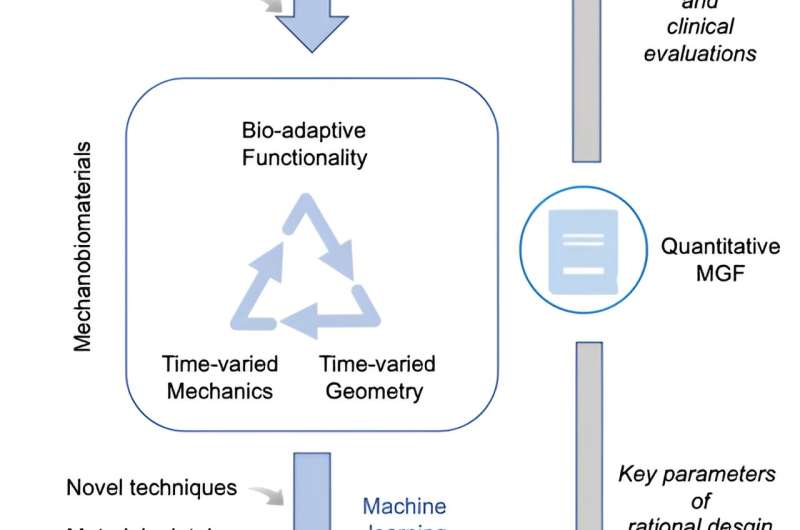This article has been reviewed according to Science X's editorial process and policies. Editors have highlighted the following attributes while ensuring the content's credibility:
fact-checked
proofread
Mechanobiomaterials: A rising field using mechanobiology principles to program functional biomaterials

A group has proposed a new concept of mechanobiomaterials, which is inspired by the natural phenomenon that biomechanics mediate tissue repair and regeneration. The rationale behind this new concept is to program the biological functionalities of biomaterials by leveraging mechanics—geometry—biological function relationships.
To profile this emerging field, the authors elucidate the fundamental principles in modulating biological responses with material–tissue mechanical interactions, illustrate recent findings on the relationships between material properties and biological responses, discuss the importance of mathematical/physical models and numerical simulations in optimizing material properties and geometry, and outline design strategies for mechanobiomaterials and their potential for tissue repair and regeneration.
The repair and functional restoration of tissue damage, such as cartilage defects, intervertebral disk degeneration, muscle loss, and heart attacks, are major challenges for clinical doctors, medical researchers, and bioengineers. Implantable and wearable biomedical devices are becoming increasingly important for tissue repair and functional restoration compared to traditional therapies.
The physical, mechanical and biochemical properties of these devices, largely rooted in the constituent materials, play a significant role in how the body responds to them. Like physiochemical interactions, the mechanical interaction between biomedical devices and tissues is also ubiquitous and important. While mechanical factors have mainly been considered for load-bearing devices and/or in static scenarios, there is potential for broader application.
Human and animal tissues have specialized structures and mechanical properties to respond to dynamic loadings during physiological activities. The extracellular matrix (ECM) transmits mechanical forces to cells, which can adjust their metabolic activities accordingly.
Tissue damage or degeneration can lead to abnormal tissue stress and strain distribution, altering the mechanical stimuli perceived by cells. This can disrupt cell signaling, compromise tissue repair, and damage healthy tissues. For example, in osteoarthritis (OA), changes in subchondral bone structure can disrupt mechanical stress patterns within the articular cartilage, leading to chondrocyte metabolism disturbances and cartilage degeneration.
The correction of abnormal cellular mechanical environments and the reconstruction of tissue mechano-adaptive processes can potentially prevent or reverse tissue pathogenesis. Several important mechanobiological signaling pathways and molecular mechanisms related to tissue regeneration have also been identified. This has led to advances in the design of biomaterials to regulate the responses of surrounding tissue and cells through mechanical interactions, resulting in enhanced tissue repair and regeneration.
Mechanobiomaterials is a fast-growing field focused on proactively designing biomaterials with specific biomechanical properties, responses or behaviors to promote tissue regeneration. The goal is to create biomaterials that can adapt to changing mechanical environments in vivo and enhance the body's regenerative potential. This field integrates biology, biomechanics, materials science, and bioengineering to create biomaterials that proactively influence cell and tissue responses through mechanical cues.
Research has shown promise in repairing various tissues and has opened up new applications. The authors summarize the fundamentals of material-tissue mechanical interactions, the relationship between material mechanics and biological responses, and the principles for designing mechanobiomaterials for tissue repair and regeneration. It is hoped that the overview will encourage further research in this area.
The findings are published in the journal Mechanobiology in Medicine. The team was led by Professors Lei Yang (Hebei University of Technology) and Huajian Gao (Tsinghua University) in China.
More information: Xiao Lin et al, Mechanobiomaterials: Harnessing mechanobiology principles for tissue repair and regeneration, Mechanobiology in Medicine (2024). DOI: 10.1016/j.mbm.2024.100079




















